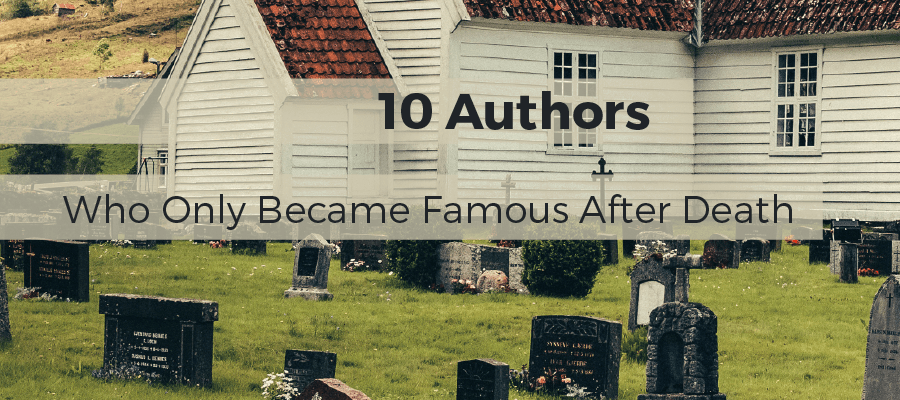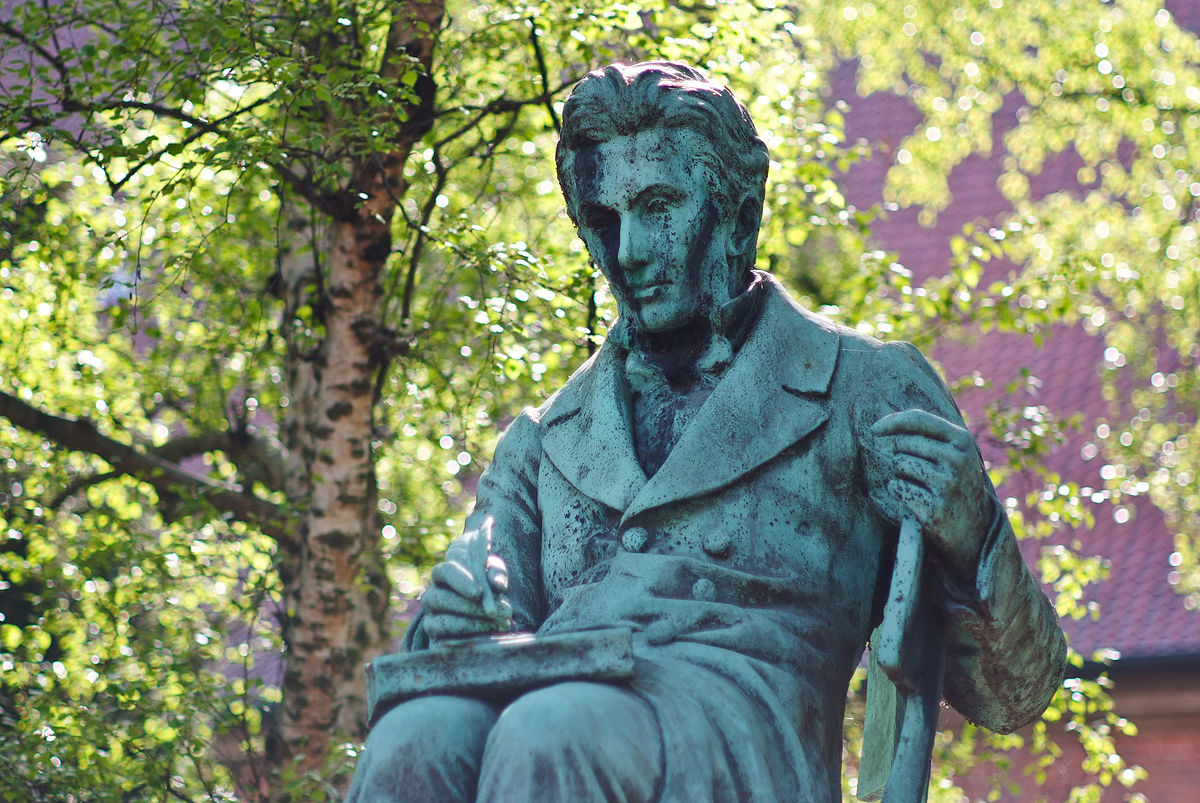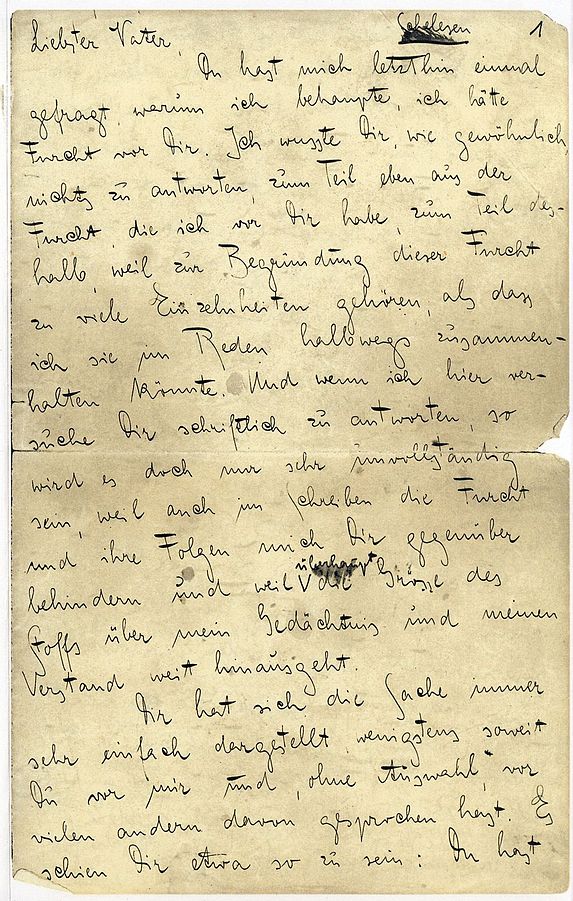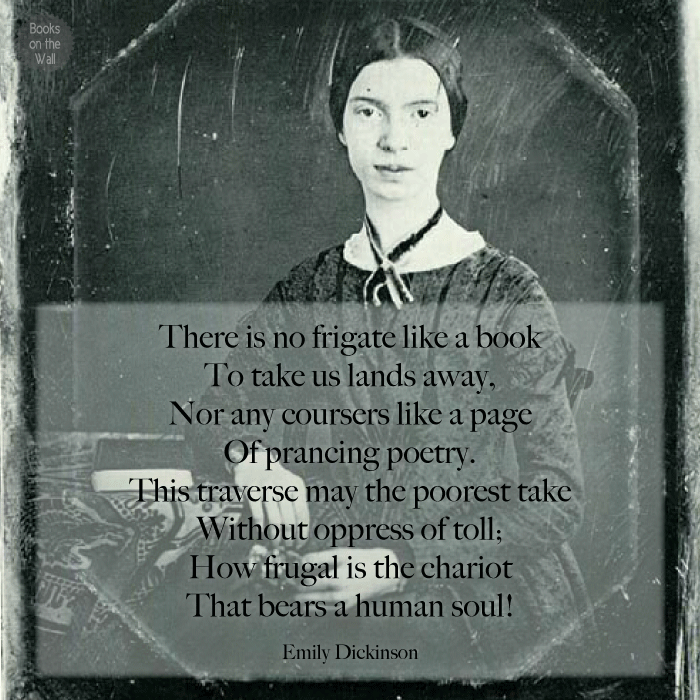10 Authors Who Only Became Famous After Death

Artists are often called the “antennae of the race.” Writers, painters, and musicians see things we normal mortals just can’t see. Sometimes it takes decades for the general public to understand what a truly gifted literary mind was trying to communicate.
In this list, you’ll find ten of the finest authors from around the world, all of whom share one sad fact: they were only fully appreciated and made famous after death.
Famous authors who reached posthumous fame
1. William Blake (1757-1827)
Contemporaries called him mad.
But today William Blake is universally recognized as a poetic and artistic genius. He was born in 1757 in London, a city he stayed in for most of his life. From a young age Blake said he had “visions” of God. His first recorded “vision” was at the age of four when he saw God “put his head through the window.” As Blake grew up, his visions became more frequent, and he desperately tried to communicate his visions of the supernatural through his work.
Blake was always a non-conformist, both in his artwork and his political views. He was a strong supporter of women’s liberation, a critic of the Anglican Church, and an admirer of the American and French Revolutions.
Blake officially worked for most of his life as a printer of illumined manuscripts. Most of his personal poetic works were painstakingly etched into these manuscripts, many of which we still have today. His most famous works include Songs of Innocence, Songs of Experience, The Marriage of Heaven and Hell, and Jerusalem, the last of which has become an unofficial anthem of England.
Although Blake ended his days in obscurity and poverty, his work was preserved by a small group of young admirers known as “the Ancients.” Apparently Blake died singing and dancing in 1827.
2. Søren Kierkegaard (1813-1855)
Modern existentialism began with Kierkegaard.

Soren Kierkegaard monument by Arne List, via Wikimedia Commons
Although this Danish writer didn’t invent the term “existentialism,” he certainly explored most of its key concepts.
Born in 1813 in Copenhagen, young Søren was heavily influenced by his melancholic and pious father Michael Kierkegaard. Søren studied theology, philosophy, and literature at the University of Copenhagen where he led a very dissolute life. He thought at the time he was inevitably going to become a pastor at the Danish People’s Church and marry a woman named Regina Olsen.
However, something snapped in Kierkegaard’s mind at this point in his life. He suddenly broke off the engagement with Olsen and decided to use the inheritance from his father’s death to become a writer.
Kierkegaard is known for using a wide variety of pseudonymous author names for his texts. His oeuvre encompasses many genres, including political tracts, Christian exegetical works, aesthetic treatises, and novels. His most studied works include Either/Or, Fear and Trembling, and The Sickness Unto Death.
Mostly mocked and ridiculed during his life, Kierkegaard collapsed on a street in September of 1855. He was taken to the Frederiksberg Hospital in Copenhagen where he died in November. Today Kierkegaard is hailed as one of the deepest religious thinkers in the Western tradition.
3. Henry David Thoreau (1817-1862)
A leading figure in the American Transcendental movement, Henry David Thoreau, was relatively unknown during his lifetime.
Thoreau was born in 1817 in Concord, Massachusetts. He was educated at Harvard in the classics, philosophy, and science. Thoreau’s first job was teaching grammar school in Concord, but he soon quit that job in protest of corporal punishment. Afterwards, Thoreau made most of his money as a surveyor around Massachusetts. Thoreau never married nor showed any interest in getting married.
Heavily influenced by Ralph Waldo Emerson, Thoreau decided to live as close to nature as possible and record his experiences. This two-year experiment in natural living by Walden Pond became one of the central works in the American literary canon: Walden; or, Life in the Woods.
Thoreau self-published most of his works and, unfortunately for him, few of them sold. Some of his more popular essays, including “Civil Disobedience,” “Walking,” and “Life Without Principle,” went on to inspire Mohandas K. Gandhi, Leo Tolstoy, and countless environmentalists around the world.
In 1860, Thoreau caught a bad case of bronchitis. Ever since that time Thoreau’s health rapidly declined. All the friends who visited Thoreau at this time were amazed by his calm acceptance of death. The famous minister Parker Pillsbury tried to talk about religion with Thoreau, but Thoreau only responded, “one world at a time.” He passed away in 1862.
If you’re a fan of Thoreau’s writing, check out our full-text Walden book poster.
4. Du Fu (712-770)
If you know anything about Chinese poetry, then you’ve heard about Li Bai and Du Fu.
These two poets are the most revered in all of Chinese history. Both of these masterminds worked during the prosperous Tang Dynasty, which lasted from 618 A.D. to 907 A.D.
While Chinese royalty hailed Li Bai for his poetic achievements in his own time, Du Fu was little recognized before his death. Most of what we know about Du Fu’s life comes from his poetry.
Du Fu (sometimes referred to as Tu Fu) was born in 712 close to the city of Luoyang in central China. His mother died when he was young, and his aunt primarily raised him. Du Fu’s father was a high-ranking official in the city, and the boy grew up reading the classic Confucius texts and studying for the civil servant exam. Surprisingly, Du Fu failed both times he took the exam.
Du Fu spent most of his life traveling around China seeking posts with various governments. Throughout his journeys he actually met Li Bai in 744. Although Du Fu greatly admired Li Bai, the older and far more famous Li Bai did not show much interest in Du Fu.
Du Fu was hired for a minor post in 755. He also married and had five children around this time. It really wasn’t until the An Lushan Rebellion broke out at the end of 755 that Du Fu began to write his more serious poetry. The horrific warfare, famine, and disease Du Fu saw around him during this turbulent time produced some of his most striking verses.
Du Fu struggled along throughout the rest of his life. He was beset by health problems as he aged, including asthma, malaria, poor eyesight, and hardness of hearing. Throughout his life, Du Fu moved from one job to the next, constantly trying to curry favor with Chinese royalty. At some times Du Fu was desperate for cash, writing poems to relatives for financial assistance.
Du Fu died in the city now called Changsha in 770. No one is sure how he died, but we know his wife and two of his sons outlived him. By all accounts Du Fu led a very difficult life, yet his poetry is full of sublime beauty, warmth, and a keen sense of morality.
Du Fu became hugely famous after death and today is arguably the most highly respected poet in all of Chinese history.
5. John Keats (1795-1821)
English poet John Keats was one of the major writers during the Romantic era.
You’ve probably heard English professors talk about the “Big Six” in a course on English Romanticism. The first generation of big Romantics all lived relatively long lives and included:
- William Wordsworth
- Samuel Taylor Coleridge
- William Blake
The second generation, however, all died young:
- John Keats
- Lord Byron
- Percy Bysshe Shelley
And no one on this list died younger than Keats.
Keats was born in London on 1795 and died of tuberculosis in 1821. Although he trained to be a doctor, Keats discovered he was squeamish while at school and decided to try his luck as a poet. All of Keats’ poems were published only four years before his death, and contemporary English critics panned all of them.
Keats lived most of his life in dire poverty, and it was only thanks to his friends that he was able to travel to Rome in search of a better climate for his tuberculosis. Keats died in Rome believing that his life was a failure. He told his friends to write, “Here lies One whose Name was writ in Water” on his tombstone, which still stands in the Cimitero Acattolico di Roma. Interestingly, Percy Bysshe Shelley, who died at the age of 29, is also buried here.

Tomb of John Keats by Giovanni Dall’Orto, via Wikimedia Commons
Today Keats has become a poetic superstar. His fifty-four poems, especially the stunning “Ode to a Nightingale” and “To Autumn,” are studied around the world. Keats’ letters are also studied in great detail by English professors. Also, Keats’ life was the subject of the 2009 hit movie Bright Star.
6. Emily Dickinson (1830-1886)
Emily Dickinson‘s poems continue to shock us in the 21st century.
This thoroughly original poet was born into a prominent family in Amherst, Massachusetts. She studied at Amherst Academy for seven years, and then attended courses at Mount Holyoke Female Seminary. After that, very little is known of Dickinson’s life. She seems to have settled for a reclusive lifestyle tending the family home. Dickinson never married.
Although Emily Dickinson sent a few of her poems out for publication in local newspapers, they were either rejected or heavily edited. Her penchant for “slants,” unusual capitalizations, and short lines were a radical break from the conventions of 19th century poetry.
As she grew older, Dickinson would sometimes shut herself in her room for extended periods of time. All of her poems numbered, and many of which deal with the themes of nature and death.
Emily told her sister Lavinia to burn all her correspondences after her death, which Lavinia did. While we don’t know what went on in Emily’s letters, thankfully Lavinia didn’t destroy the 1,800 poems she discovered in one of her sister’s drawers.
Emily Dickinson died in 1886 due to Bright’s disease. Although unknown during her lifetime, Dickinson has become known one of America’s finest poets.
7. Herman Melville (1819-1891)
Even people who’ve never read Moby-Dick know about mad Captain Ahab and the great white whale. However, few people know that this classic novel was neglected for over 50 years.
Herman Melville was born in 1819 in New York City. He lived a seafaring life for most of his twenties, sailing as far as the Marquesas Islands and finally returning to Boston in 1844.
Melville wrote down fictionalized accounts of his voyages in a work that became known as Typee. This novel, published in 1845, was a success, and Melville followed it up with the novel Omoo.
Although these early novels were financially successful, Melville was striving to write a more “serious” novel in the style of Nathaniel Hawthorne, with whom he was acquainted. His first attempt to write a truly experimental novel was Moby-Dick, which he dedicated to Hawthorne and published in 1851. This book was Melville’s first major failure as a writer. In order to support himself and his family, Melville eventually had to work as a customs official in NYC.
Although he was completely forgotten in the literary world, Melville continued to write some of the most influential short stories in American literature. A few of these stories include “Bartleby, the Scrivener” and “Benito Cereno.” One novella, entitled Billy Budd, was actually discovered in a tin after Melville died of a cardiovascular disease in 1891.
In 1919, the so-called “Melville Revival” took place around the Western world. Literary critics and authors began heavily promoting Melville’s later work. Authors as prominent as D.H. Lawrence, William Faulkner, and Hart Crane couldn’t stop singing the praises of Melville’s magnificent Moby-Dick. Today Melville is considered one of the central figures of American Romanticism.
Fans of Melville’s prose should check out our Moby-Dick book poster.
8. John Kennedy Toole (1937-1969)
The American author John Kennedy Toole is known for one major book, A Confederacy of Dunces, which won the Pulitzer Prize in 1981.
Unfortunately, Toole was not there to accept the award. He had committed suicide 12 years earlier.
Toole was born in New Orleans in 1937 into a middle class family. Thelma, Toole’s mother, had a very negative effect on the young boy. Apparently Thelma dictated what Toole could and couldn’t do throughout his entire life.
Toole was exceptionally brilliant at a young age. He was able to skip the first grade, and he wrote his first novel (The Neon Bible) at the age of 16. Toole went on to study English at Tulane University, earning both a B.A. and a Master’s. He went on to become the youngest professor at Hunter College. Despite his growing social circle, Toole seemed dissatisfied with academia.
In 1961, Toole enlisted in the army and was stationed at San Juan, Puerto Rico. While in Puerto Rico, Toole began work on his masterpiece A Confederacy of Dunces. Toole was sent back home, however, to support his ailing father. In order to help his family, Toole taught English at a local school. In his spare time, Toole finished his comic novel about the lazy and pretentious man Ignatius J. Reilly.
Toole became frustrated after many failed attempts to find a publisher for his work. As the months progressed, Toole became more paranoid, took to drinking, and lost his job as a teacher. After a fight with his mother, Toole withdrew all his savings and left home. He was later discovered dead in Biloxi, Mississippi. He was only 33.
It was thanks to Thelma that A Confederacy of Dunces finally got published in 1980. After the book won the Pulitzer, it grew in popularity around the world. Today this book can be read in around 30 languages.
9. Philip K. Dick (1928-1982)
Even if you haven’t read a single book by American author Philip K. Dick, you’ve probably seen a movie inspired by his work.
Just a few of the films his novels helped inspire include:
- Total Recall
- Blade Runner
- Imposter
- Minority Report
- A Scanner Darkly
Despite his battles with drug addiction, anxiety, and poverty, Dick was an extremely prolific writer in the then nascent genre of sci-fi. Born in Chicago in 1928, Dick spent most of his life in California. Watch this BBC documentary to learn more about Dick’s life:
Dick did achieve a little bit of fame in 1963 when he won the Hugo Award for his novel The Man in the High Castle, but mainstream approval always eluded him. At the end of his life, Dick had 44 published novels and 121 published short stories to his name.
Several themes fill nearly all of Philip K. Dick’s works:
- Paranoia
- Drug abuse
- Religious ecstasy
- The nature of reality
- Technology
Dick himself reported having numerous paranormal and religious experiences. At one point in his life, Dick actually believed the spirit of Elijah possessed his mind. One section of Dick’s novel Flow My Tears, the Policeman Said attempted to describe this religious ecstasy in a modern retelling of the Book of Acts.
In 1982, Dick called his therapist and told him that he was going blind. When advised to go to the emergency room, however, Dick stayed at home. He was later found unconscious in his Santa Ana home. As he was rushed to the hospital, Dick suffered another stroke and was put on life support. After doctors told Dick’s family that his brain activity had ceased, they decided to remove life support on March 2.
The truly sad part about Dick’s death is that he was finally getting national recognition after the premier of Ridley Scott’s Blade Runner a few months earlier.
Today Philip K. Dick is beloved by casual readers and critics alike. His 1969 novel Ubik has been hailed by Time magazine as one of the greatest English novels of the century, and Dick was honored in 2007 as the first sci-fi author in the Library of America.
10. Franz Kafka (1883-1924)
Just like Emily Dickinson, Czech writer Franz Kafka wanted all of his literary works and letters burned at the time of his death.
Thankfully, Kafka’s friend Max Brod did no such thing. Instead, Brod published all of Kafka’s masterful short stories and novels, as well as many of his letters.
As many Western authors before him, Kafka led a very sad life. Born in Prague in 1883, Kafka became the only son in a Jewish family after his two brothers, Georg and Heinrich, died when Kafka was only six. Kafka’s three sisters were later killed during World War II in a Polish ghetto.
Hermann, Kafka’s father, was extremely overbearing. Kafka’s timid mother, Julie, rarely stood up for the poor child. Kafka’s strained relationship with his father can be seen in all areas of his life and in his fiction.

Brief an den Vater (Letter to his father), via Wikimedia Commons
After graduating with a law degree from the University of Prague, Kafka spent most of his life working in insurance, a job he detested. It was only at night that Kafka let his brooding imagination soar in his fiction. In 1923 he attempted to make a living as a writer in Berlin, but he almost immediately caught tuberculosis and passed away in 1924.
Today people from around the world come to visit Kafka’s museum in Prague to both learn and pay respect to this master of modern fiction. Kafka is perhaps best known for his short story “The Metamorphosis” as well as his novels Amerika, The Castle, and The Trial, all of which were published posthumously.










Leave a Reply
1 Comment on "10 Authors Who Only Became Famous After Death"
[…] The Tang Dynasty, which lasted between 618 and 907 AD, is still considered a golden age in Chinese literary history. During this time, China produced its two greatest poets: Li Bai (Chinese: 李白) and Du Fu. If you’re interested, you can read more about Du Fu in one of our previous posts. […]